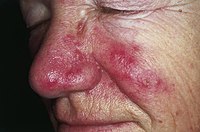
Photo from wikipedia
The purpose of this study was to investigate the effects of various exercise modalities on inflammatory factors in middle-aged and elderly patients with type 2 diabetes (MEPT2D), as lifestyle changes,… Click to show full abstract
The purpose of this study was to investigate the effects of various exercise modalities on inflammatory factors in middle-aged and elderly patients with type 2 diabetes (MEPT2D), as lifestyle changes, such as physical activity and dietary modifications, are considered important in the prevention of type 2 diabetes. For the study methodology, Pubmed, CNKI, EBSCO, Wanfang Data, and Web of Science were selected for the search. The methodological quality of the included studies was assessed by the Cochrane Risk of Bias (ROB) tool, and statistically analyzed using the RevMan 5.4.1 analysis software, which included 18 investigations involving 853 study subjects. Meta-analysis findings indicated that aerobic training (AT), resistance training (RT), combined training (CT), and high-intensity interval training (HIIT) showed significant reductions in CRP, TNF-α, IL-6, and IL-10 levels in MEPT2D. Among them, HIIT was superior to other training modalities in reducing TNF-α levels, while CT was superior to AT, RT, and HIIT in decreasing IL-6, IL-10, and CRP in MEPT2D. Meanwhile, RT had limited effects in reducing CRP and TNF-α levels in MEPT2D. However, HIIT had no significant effect on IL-6 and IL-10 in MEPT2D. In conclusion, long-term regular AT, RT, CT, and HIIT all contributed to the reduction of inflammatory status (CRP, TNF-α, IL-6, and IL-10) in MEPT2D, while CT (for CRP, IL-6, and IL-10) and HIIT (for TNF-α) represent the best approaches to counteract the inflammatory response in MEPT2D.
Journal Title: International Journal of Environmental Research and Public Health
Year Published: 2023
Link to full text (if available)
Share on Social Media: Sign Up to like & get
recommendations!